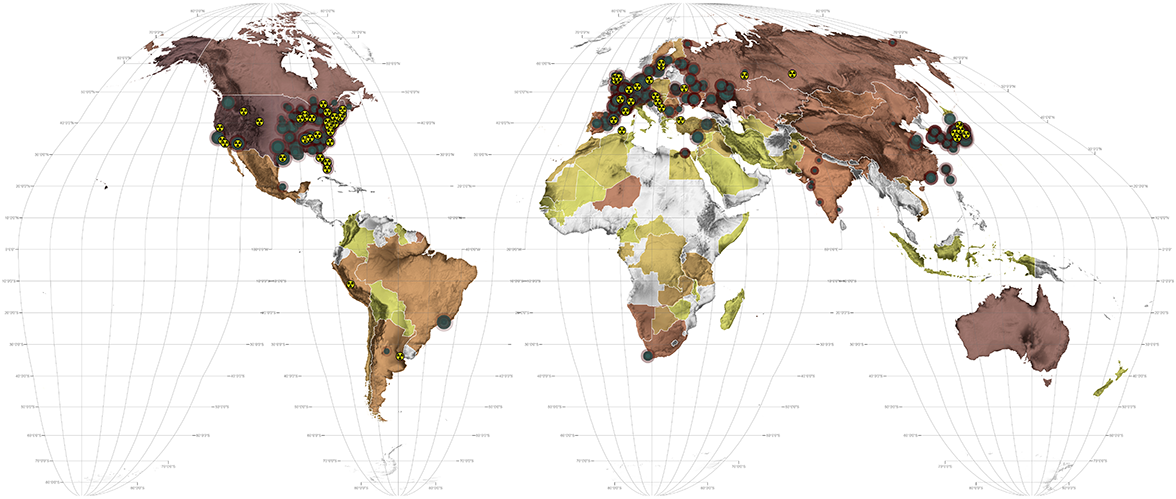At the close of 2015 there were 439 operable nuclear reactors around the world. 1 Nuclear power production creates roughly 10% of the world's electricity supply. The industry representative, The World Nuclear Association, aims to increase that figure to 25% by 2050 and to that end, 66 new civil power reactors are under construction around the world and another 158 in planning stages. On average, reactors take about 6 years to build and last for 60.
Despite a reputation tarnished by association with nuclear weaponry, reactor meltdowns at Three Mile Island (1979), Chernobyl (1986), and Fukushima (2013) and fears regarding waste stock-piles, the nuclear energy industry stands to benefit from its carbon neutral status. Although it uses significant amounts of water in its process, nuclear energy production can produce prodigious amounts of energy from relatively minor inputs. A kilogram of uranium 235, which constitutes 0.72% of mined uranium, releases the energy equivalent to 2,700 tons of coal. Estimates of global uranium supplies vary from lasting 80-270 years.
The World Nuclear Association calculates that "[g]enerating enough electricity for one person produces just 30 grams of used fuel each year." 2 Used nuclear fuel, however, is radioactive and cancerous. There is about 240,000 tons of used fuel in storage world-wide, much of it at reactor sites. It must be stored inside thick structures of concrete or steel, or covered by a few meters of water for up to 50 years before its radioactivity has dropped to relatively safe levels.
Each year, nuclear power generation facilities worldwide produce about 200,000 m3 of low and intermediate level radioactive waste, and about 10,000 m3 of high level waste. A typical 1000 MWe light water reactor will generate about 200-350 m3 low and intermediate level waste per year. This compares with an average 400,000 tons of ash produced from a coal-fired plant of the same power capacity. When nuclear power plants shut down, they are either dismantled and decontaminated or enclosed to await dismantling or, if radioactive material is to remain in situ, the whole facility is 'entombed'.
1 World Nuclear Association, "World Nuclear Performance Report 2016," http://www.world-nuclear.org/our-association/publications/online-reports/world-nuclear-performance-report-2016.aspx (accessed September 9, 2016).
2 World Nuclear Association, "What are nuclear wastes and how are they managed?" http://www.world-nuclear.org/nuclear-basics/what-are-nuclear-wastes.aspx (accessed September 9, 2016).
1. Nuclear Reactors
"Operational Nuclear Reactors," The Guardian, data sourced from the World Nuclear Association, https://www.theguardian.com/news/datablog/2011/mar/18/nuclear-reactors-power-stations-world-list-map#data (accessed June 21, 2015).
2. Nuclear Accidents
Benjamin K. Sovacool, "The Cost of failure: A preliminary assessment of major energy accidents, 1907-2007," Energy Policy 36, no. 5 (2008): 1802-1820.
"Nuclear power plant accidents: listed and ranked since 1952," The Guardian, data partially sourced from the International Atomic Energy Authority, https://www.theguardian.com/news/datablog/2011/mar/14/nuclear-power-plant-accidents-list-rank#data (accessed June 21, 2015).
3. National Uranium Deposits
International Atomic Energy Agency (IAEA): Integrated Nuclear Fuel Cycle Information Systems (INFCIS), "World Distribution of Uranium Deposits," https://infcis.iaea.org/UDEPO/UDEPOMain.asp?Order=1&RPage=1&Page=1&RightP=List (accessed June 21, 2015).



